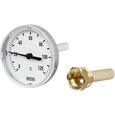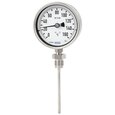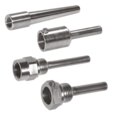Bimetallic Thermometer Applications
Figure 1: Bimetallic thermometer
A bimetallic thermometer is a temperature sensor that operates on the principle of thermal expansion of metals. With the capacity to endure vibration, corrosion, and temperature extremes, bimetallic thermometers are frequently employed across various sectors, including manufacturing, energy, and processing industries. This article discusses the main selection criteria and industrial applications of bimetallic thermometers.
View our bimetallic thermometer selection here!
Selection criteria
Consider the following parameters while selecting a bimetallic thermometer for an application.
- Stem size: The stem size determines the insertion depth into the measured medium. Thicker stems provide better thermal conductivity and faster response times. Choose a stem length sufficient to reach the point of interest in the medium while avoiding unnecessary immersion to minimize thermal lag.
- Connection type: The connection type determines how the thermometer mounts or connects to the equipment. There are threaded, fixed flange, union, and ones with compression fittings. Thermowells offer additional protection for the stem in harsh environments.
- Temperature range: Bimetallic thermometers typically cover a wide range, from -70°C to +600°C, depending on the specific model and metal combination. Choose a range covering the expected operating temperatures with some buffer (e.g., 20% above and below). Operating outside the range can damage the bimetallic strip and affect accuracy.
- Mounting type: Under-connection (stems and process connections below the cabinet) is useful in tight spaces with its compact design and protected connection. However, accessing the connection or reading the temperature might be trickier. Rear-connection (stems and process connections located behind the cabinet) provides easy installation and clear readings but exposes the stem and requires more space behind the equipment.
-
Accuracy class:The accuracy class is a tolerance level for how much the thermometer's indication can deviate from the actual temperature. The common accuracy classes are the following:
- Class 1: ±1% of full-scale range (highest accuracy)
- Class 2: ±2% of full-scale range (most common)
- Class 3: ±3% of full-scale range (suitable for less critical applications)
- Material compatibility: Ensure the bimetallic strip materials are compatible with the measured medium.
-
IP protection:Choosing an IP rating depends on the environment:
- Low dust/moisture: IP54 (dustproof, splashproof).
- Moderate dust/moisture: IP65 (dustproof, water jet protected).
- High dust/moisture: IP67 (dustproof, submersible up to 1m).
Read our bimetallic thermometer calibration article for more information on how to calibrate a bimetallic thermometer.
Applications
Read our bimetallic thermometer overview article for more details on the workings and features of this thermometer. Bimetallic thermometers are versatile instruments used in various industrial applications.
Control devices
- HVAC thermostats: Spiral strip-type bimetallic thermometers are integral to the operation of air conditioning thermostats. The bimetallic element responds to temperature changes, triggering the HVAC system to maintain the set temperature, ensuring energy efficiency and occupant comfort.
- Industrial process control: Bimetallic thermometers are used in various refinery processes, measuring temperatures in distillation columns, pipelines, and storage tanks. In hazardous environments where sparks from traditional electric sensors pose a risk, bimetallic thermometers provide a safe alternative. They are used in industrial heaters like boilers and furnaces to regulate temperature and prevent overheating.
- Safety mechanisms: Bimetallic thermometers are used in safety devices like fire detection systems and emergency shut-offs, where their rapid response to temperature spikes can initiate critical protective actions.
Industrial equipment
- Tire vulcanizers: The manufacturing of tires involves vulcanization, a process requiring precise temperature control. Bimetallic thermometers are used here to monitor and adjust the heat to the optimal level for rubber curing.
- Oil burners: In the operation of oil burners, maintaining the correct combustion temperature is essential. Bimetallic thermometers provide real-time feedback, allowing adjustments to ensure efficient fuel consumption and reduce emissions.
- Tempering tanks: In the metalworking industry, tempering tanks use bimetallic thermometers to monitor and maintain the temperatures required for tempering metals, impacting the final material properties.
FAQ
How does a bimetallic thermometer work?
A bimetallic thermometer measures temperature using a coiled strip of two metals that expand at different rates, causing it to unwind or wind up as temperatures change.









